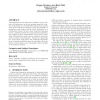EVOW
2009
Springer
14 years 6 months ago
2009
Springer
We consider a swarm of robots equipped with an infrared range and bearing device that is able both to make estimates of the relative distance and angle between two robots in line-o...
MOBIHOC
2003
ACM
14 years 11 months ago
2003
ACM
In wireless ad hoc networks, capacity can be traded for delay. This tradeoff has been the subject of a number of studies, mainly concentrating on the two extremes: either minimizi...
MOBIHOC
2004
ACM
14 years 11 months ago
2004
ACM
We present the Feasible Label Routing (FLR) protocol for mobile ad hoc networks, which uses path information to establish routes to destinations on demand. FLR enables loopfree in...
MOBIHOC
2004
ACM
14 years 11 months ago
2004
ACM
APS algorithms use the basic idea of distance vector routing to find positions in an ad hoc network using only a fraction of landmarks, for example GPS enabled nodes. All the node...
MOBIHOC
2001
ACM
14 years 11 months ago
2001
ACM
A Bluetooth ad hoc network can be formed by interconnecting piconets into scatternets. The constraints and properties of Bluetooth scatternets present special challenges in formin...
MOBIHOC
2002
ACM
14 years 11 months ago
2002
ACM
This paper investigates two fundamental characteristics of a wireless multihop network: its minimum node degree and its k?connectivity. Both topology attributes depend on the spat...
MOBIHOC
2008
ACM
14 years 11 months ago
2008
ACM
Simulation of network protocol behavior in Vehicular Ad Hoc Network (VANET) scenarios is strongly demanded for evaluating the applicability of developed network protocols. In this...
MOBIHOC
2008
ACM
14 years 11 months ago
2008
ACM
Ad hoc networks formed by traveling vehicles are envisaged to become a common platform that will support a wide variety of applications, ranging from road safety to advertising an...
PERCOM
2007
ACM
14 years 11 months ago
2007
ACM
? Peer-to-peer is a popular distributed system. With the advancement in mobile technologies, mobile p2p has revealed its attraction. But, the resource constraints such as bandwidth...
PERCOM
2007
ACM
14 years 11 months ago
2007
ACM
Cooperative communications fully leverages the broadcast nature of the wireless channel and spatial diversity, thereby achieving tremendous improvements in system capacity and dela...




